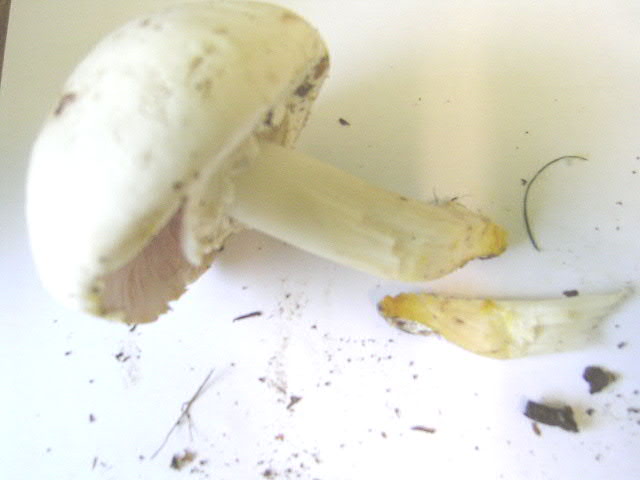- Agaricus xanthodermus
Taxobox
color = lightblue
name = Yellow Staining Mushroom
status = secure

image_width = 200px
regnum = Fungi
divisio =Basidiomycota
classis =Agaricomycetes
subclassis =Homobasidiomycetidae
ordo =Agaricales
familia =Agaricaceae
genus = "Agaricus "
species = "A. xanthodermus"
binomial = "Agaricus xanthodermus"
binomial_authority = Genev.mycomorphbox
name = Agaricus xanthodermus
whichGills = free
capShape = convex
hymeniumType=gills
stipeCharacter=ring
ecologicalType=saprotrophic
sporePrintColor=brown
howEdible=poisonousThe yellow-staining mushroom, "Agaricus xanthodermus", is amushroom of thegenus "Agaricus ", which displays a strong yellow coloration at the base of the stem when cut. It is poisonous for most people, causing gastrointestinal upsets but is eaten by some without apparent negative effect.Taxonomy
The yellow-staining mushroom was officially described in 1876. The epithet "xanthodermus" is derived from the
Ancient Greek words for "yellow-skinned"; this is the name used by many authorities, such as [http://www.indexfungorum.org/Names/genusrecord.asp?RecordID=18608 Index Fungorum] . However the form "Agaricus xanthoderma" is also often seen, [Meinhard Moser, translated by Simon Plant: "Keys to Agarics and Boleti" (Roger Phillips 1983) ISBN 0-9508486-0-3] and in fact this is more correct in classical terms; here "-derma" (δέρμα) is a Greek neuter noun, not an adjective which would agree in gender with "Agaricus".Description
The cap is generally 6-10 cm in diameter, though can reach 15cm. It is initially convex, with some young specimens having a squarish shape, though flattening with age. It is whitish, with light brown tints towards the center. The cap is dry and smooth, but can be scaly when old. The gills of this mushroom progress from pale-pink to a chocolate color. The spore print is brown. Its white stipe is bulbous with a skirt-like ring. Microscopically, there are club-shaped cheilocystidia. The spores are 6-7×3-4µ.
The main identifying feature is an immediate bright yellow coloration on cutting through the base of the stem, or scraping the flesh; later the affected area fades to a dull brown. Numerous edible "Agaricus" species, such as "A. augustus", "A. arvensis" and "A. silvicola", go yellow to a greater or lesser extent, but they do not display such an intense reaction.
"Agaricus xanthodermus" has an unpleasant characteristic smell, which is phenolic (i.e. like ink or carbolic soap). The smell is especially strong at the base of the stem. On cooking the smell becomes very noticeable, and in some cases this has deterred people from eating it inadvertently.
Distribution and habitat
This mushroom is very common and widely distributed in
North America andEurope , and is also found in North Africa, Courtecuisse, R. & Duhem, B. (1994) "Guide des champignons de France et d'Europe" Delachaux et Niestlé ISBN 2-603-00953-2, also available in English] and easternAnatolia in Turkey,cite journal |author=Demirel K, Uzun Y, Kaya A |year=2004|title=Some Poisonous Fungi of East Anatolia |journal=Turk J Bot |volume=28|pages=215–19|id= |url=http://journals.tubitak.gov.tr/botany/issues/bot-04-28-1-2/bot-28-1-2-23-0207-2.pdf|format=PDF |accessdate= 2008-02-08] and has been introduced intoAustralia . It occurs in woods, lawns, gardens and hedgerows in autumn. This is asaprobic species.Related species
"A. xanthodermus" belongs to a group of related species (the "Xanthodermatei") which likewise discolour bright yellow and have a phenolic smell. They include "A. praeclaresquamosus" (formerly "A. placomyces") which has dark grey scales, and "A. pilatianus" which does not have a bulbous stem.
References
* Collins Gem Guide: "Mushrooms and Toadstools", Stefan Buckzacki (1982).
External links
* [http://healing-mushrooms.net/archives/agaricus-xanthodermus.html “"Agaricus xanthodermus"”] by Robert Sasata, "Healing-Mushrooms.net", November, 2007.
Wikimedia Foundation. 2010.
